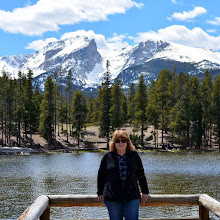"But I think I love fall most of all."
Yes, I do!
Autumn has always been my favorite season. I've been blogging about scenic trips we took last year at this time of the year but I thought I'd update you about what we have been doing this unusual year...
These fall views were all taken in my community. I worried that the early September frost and snow we had, along with our prolonged summer drought, might change the appearance of autumn this year, but I think October brought us the brightest local colors I've seen since moving to Colorado almost eight years ago.
Even the ash tree in front of my home was never more beautiful!
As you can see, my oldest granddaughter standing under it is getting tall!
The deer enjoyed the pleasant fall weather to forage and relax often in our backyard.
I always enjoy seeing them.
In October my husband and I were able to take some nature hikes in our neighborhood, delight in fresh figs from our fig tree, use our new backyard barbecue grill, eat lots of healthy salads, enjoy the last of the summer flowers, appreciate the bright fall colors outside our windows and most importantly we were able to vote!
Colorado is a "vote by mail or ballot drop off " state each election. We received our ballots and an information booklet with information about the proposals and state amendments on the ballot, which gave us the ability to do research before we filled it in and dropped it off in an official ballot collection box. We signed up to be notified by text mail of the progress of our ballot and three days later we received a message our ballot was received and recorded. It is a very easy voting procedure--we love it!
One of the other joys of this October was watching our grandsons play Little League baseball. They had a wonderful time playing and we divided our time between both of their games on the weekends to cheer them on. The children all wore face masks when sitting on the bench, and they each had their own equipment, so there was minimal contact exposure.
Our youngest granddaughter, their sister, also enjoyed watching their baseball games. The last game was played in chilly weather so she wore her new teddy bear hat and winter jacket. Even though we were outdoors we all wore masks as it was hard to social distance sitting on the bleachers. Sadly, covid cases are going up in Colorado, as well as in almost all the midwest states, so we are all trying to be as careful as we can. We sadly know people who have gotten very ill from covid and some who have died from it, so we take it very seriously.
Wildfire smoke in the atmosphere as seen from Golden, Colorado
Sadly, although we had a wonderful October at our home, the state of Colorado saw devastating wildfires grow. The Cameron Peak fire has burned 208,663 acres and is about 64% contained. The Cameron Peak fire is burning in the Roosevelt National Forest west of Fort Collins and is the largest recorded wildfire in state history. More than 1,800 personnel are fighting the fire.
The East Troublesome fire, which is burning southwest of the Cameron Peak fire just north of Granby and into Rocky Mountain National Park, had burned 192,560 acres and was 10% contained Sunday. High winds were fueling both fires and they were both growing fast. Grand County and the town of Estes Park were evacuated for safety. The Lefthand Canyon Fire has reached 100 percent containment, but the CalWood Fire was still burning on Friday at 10,073 acres and 55 percent containment. Nearly 500 personnel are helping to fight the CalWood Fire, which is burning north of Jamestown in Boulder County.
I am heartbroken to think of the environmental damage being done, and the loss of life and property from the wildfires. We had snow this weekend but although the fire management crews are hopeful that the snowstorm will help them battle the wildfires, they aren't relying on the weather to end them. We may need much more snow and or rain to put them out completely as they are burning extremely hot and deep into the ground in extremely mountainous regions.
If anyone is interested in helping the victims of the wildfires you can find resources on this website: Colorado Responds. Please keep all those affected and all the brave firefighters in your prayers.
I hope your October was a good one and that those who celebrate will have a very Happy Halloween!
Stay happy, safe, and healthy!
You can also find me on
I'm linking this post to some of the following blog events:
Mosaic Monday, All Seasons, Blue Monday, Through My Lens Monday, Little Cottage Link Party, Hearth, and Soul Link Party, You Are the Star Blog Hop, Inspire Me Monday, Home Matters Linky Party, Good Random Fun, Nature Notes, Grand Social, Travel Photos, Happiness Is Homemade, Over the Moon, Create, Bake, Make, Our World Tuesday, Ruby Tuesday, Tuesday Turn About. Tuesdays With A Twist, Let's Keep In Touch, Wordless Wednesday on a Tuesday, Party in Your PJ's, Wordless Wednesday, Nanahood WW, Oh My Heartsie Girl's Wonderful Wednesday, Your Whims Wednesday, Wednesday My Corner of the World, Wonderful Wednesday, Little Things Thursday, Thankful Thursday, Thursday Encouraging Hearts and Home, Thursday Thinking Out Loud, Friendship Fridays, Friday Features Linky Party, Skywatch Friday, Pink Saturday 



























































